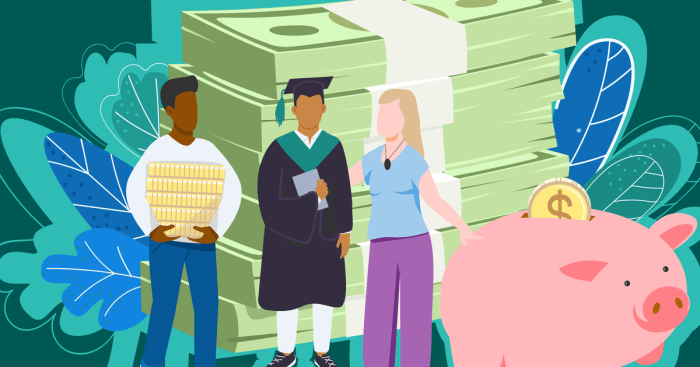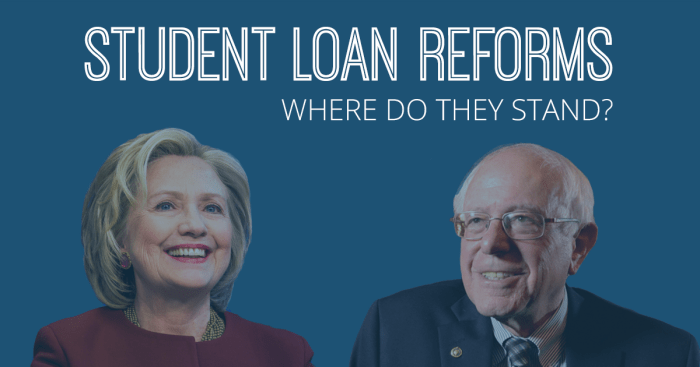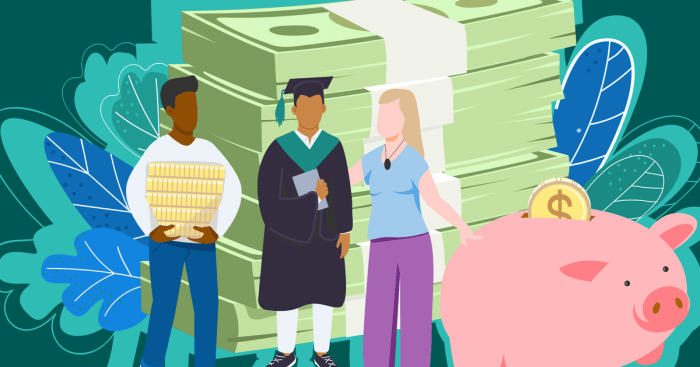In the face of the ever-growing student loan crisis, advocacy groups and organizations have emerged as beacons of hope for millions of borrowers struggling under the weight of overwhelming debt. These dedicated entities are at the forefront of the fight for student loan reform, tirelessly advocating for policies that provide relief, fairness, and accessibility in higher education.
Their missions are as diverse as the challenges they confront, ranging from pushing for loan forgiveness and affordable repayment plans to promoting tuition-free college and addressing the racial wealth gap in education. Through strategic campaigns, grassroots organizing, and legislative lobbying, these groups are making a tangible difference in the lives of student loan borrowers across the nation.
Advocacy Groups and Organizations
Student loan reform has gained momentum in recent years, with advocacy groups and organizations playing a crucial role in shaping the debate and advocating for change. These groups work tirelessly to raise awareness, educate the public, and push for legislative action to address the growing student loan debt crisis.
These advocacy groups and organizations employ a variety of strategies to promote student loan reform, including:
- Conducting research and publishing reports to inform the public and policymakers about the impact of student loan debt.
- Organizing protests, rallies, and other events to raise awareness and mobilize public support.
- Lobbying elected officials and working with policymakers to develop and pass legislation that addresses student loan debt.
- Providing resources and support to student loan borrowers, such as counseling, legal assistance, and financial aid advice.
Prominent Advocacy Groups and Organizations
Among the most prominent advocacy groups and organizations working on student loan reform are:
- The Student Debt Crisis Center: A non-profit organization dedicated to raising awareness about the student loan debt crisis and advocating for policy changes to address it.
- The National Consumer Law Center: A non-profit organization that works to protect the rights of consumers, including student loan borrowers, and advocates for fair lending practices.
- The American Federation of Teachers: A labor union representing teachers and other education professionals, which has been a vocal advocate for student loan reform and affordable higher education.
- The National Education Association: Another labor union representing teachers and other education professionals, which has also been a strong advocate for student loan reform and increased funding for public education.
Successful Campaigns and Initiatives
Advocacy groups and organizations have led several successful campaigns and initiatives to promote student loan reform, including:
- In 2020, the Student Debt Crisis Center and other advocacy groups successfully pressured the U.S. Department of Education to suspend student loan payments and interest during the COVID-19 pandemic.
- In 2021, the National Consumer Law Center and other advocacy groups successfully lobbied Congress to pass legislation that made it easier for student loan borrowers to discharge their loans in bankruptcy.
- In 2022, the American Federation of Teachers and other advocacy groups successfully pushed the Biden administration to forgive $10,000 in student loan debt for millions of borrowers.
Key Issues and Concerns
Student loan reform advocacy groups are addressing several key issues and concerns that have significant implications for borrowers, the economy, and society as a whole. These issues highlight the urgent need for comprehensive reforms to ensure accessible, affordable, and responsible student lending practices.
One of the primary concerns is the rising student loan debt, which has reached unprecedented levels in the United States. According to the Federal Reserve, outstanding student loan debt surpassed $1.7 trillion in 2022, making it the second-largest consumer debt category after mortgages.
This staggering debt burden has far-reaching consequences for borrowers, affecting their financial stability, mental well-being, and career prospects.
Financial Burdens and Economic Implications
The high cost of student loans places a significant financial strain on borrowers, particularly those from low-income and middle-class families. Many graduates struggle to repay their loans while meeting basic living expenses, such as rent, food, and transportation. This can lead to delayed homeownership, difficulty saving for retirement, and reduced consumer spending, which has negative implications for the overall economy.
The burden of student loan debt also contributes to wealth inequality. Borrowers from marginalized communities, including Black and Hispanic students, often face higher default rates and have difficulty accumulating wealth compared to their white counterparts. This perpetuates existing disparities and limits economic mobility.
Mental Health Implications
The stress and anxiety associated with student loan debt can have a profound impact on borrowers’ mental health. Studies have shown that individuals with high student loan debt are more likely to experience depression, anxiety, and suicidal thoughts. The constant pressure to repay loans can lead to feelings of hopelessness, shame, and isolation.
Furthermore, the financial uncertainty and limited career opportunities resulting from student loan debt can exacerbate mental health issues. Borrowers may feel trapped in jobs they dislike or underemployed, which can contribute to low self-esteem and a sense of unfulfillment.
Career Prospects and Limited Opportunities
Student loan debt can also limit borrowers’ career prospects and opportunities. Many graduates are forced to take jobs that offer higher salaries to repay their loans, even if those jobs do not align with their passions or long-term career goals.
This can lead to job dissatisfaction, lower productivity, and reduced innovation.
Additionally, the fear of defaulting on student loans can discourage borrowers from pursuing higher education or starting their own businesses. This can have a chilling effect on entrepreneurship and innovation, hindering economic growth and social progress.
Legislative and Policy Proposals
Advocacy groups and organizations working on student loan reform have proposed various legislative and policy measures to address the student loan crisis. These proposals aim to provide relief to borrowers, make higher education more affordable, and ensure equitable access to quality education.
Loan Forgiveness
One key proposal is student loan forgiveness, which involves canceling a portion or all of the outstanding student loan debt owed by borrowers. This measure aims to alleviate the financial burden of student loans, particularly for those who are struggling to repay their loans or have defaulted on their payments.
The Biden administration has announced plans to forgive $10,000 in federal student loan debt for borrowers earning less than $125,000 per year or households earning less than $250,000 per year. Some advocacy groups are pushing for more comprehensive loan forgiveness programs, such as canceling all federal student loan debt or forgiving a larger portion of the debt for borrowers who meet certain criteria.
Income-Driven Repayment Plans
Another proposal is to expand and improve income-driven repayment (IDR) plans, which allow borrowers to cap their monthly student loan payments at a percentage of their discretionary income. This measure aims to make student loan payments more manageable for borrowers who are struggling to repay their loans.
Advocacy groups are calling for reforms to existing IDR plans, such as lowering the percentage of income that borrowers are required to pay, extending the repayment period, and forgiving any remaining debt after a certain number of years in repayment.
Tuition-Free College
Some advocacy groups and organizations are also advocating for tuition-free college, which would make public colleges and universities tuition-free for all students. This measure aims to make higher education more affordable and accessible to all students, regardless of their financial background.
Proposals for tuition-free college vary in terms of how they would be funded and implemented, but they generally involve increasing government funding for public colleges and universities or creating new funding mechanisms, such as a tax on financial transactions.
Challenges and Obstacles
Advocacy groups and organizations face several challenges and obstacles in advancing their legislative agenda. One challenge is the high cost of implementing some of the proposed measures, such as loan forgiveness or tuition-free college. Another challenge is the political divide over these issues, with some lawmakers opposing measures that would increase government spending or provide debt relief to borrowers.
Additionally, advocacy groups often face opposition from the for-profit college industry and other stakeholders who benefit from the current system of student lending.
Public Awareness and Engagement
Advocacy groups employ various strategies to raise public awareness about the student loan crisis and mobilize support for reform.
These strategies include public awareness campaigns, social media initiatives, and grassroots organizing efforts.
Public Awareness Campaigns
Advocacy groups conduct public awareness campaigns to educate the public about the student loan crisis and its impact on individuals, families, and the economy.
- These campaigns use a variety of media, including print, broadcast, and online, to reach a wide audience.
- They often feature personal stories from student loan borrowers who have struggled to repay their debts.
- Public awareness campaigns aim to raise awareness of the issue and build support for reform.
Social Media Initiatives
Advocacy groups use social media platforms to connect with potential supporters and spread awareness about the student loan crisis.
- They share information about the issue, organize online events, and encourage people to take action.
- Social media initiatives can be an effective way to reach a large and diverse audience.
- They can also help to build a sense of community among student loan borrowers and advocates.
Grassroots Organizing Efforts
Advocacy groups also engage in grassroots organizing efforts to build support for student loan reform at the local and state levels.
- These efforts include organizing rallies, protests, and lobbying events.
- Grassroots organizing can help to raise awareness of the issue and put pressure on elected officials to take action.
- It can also help to build a network of activists who are committed to fighting for student loan reform.
Public opinion and pressure play a significant role in shaping policy decisions related to student loan reform.
When the public is aware of the issue and supports reform, it can put pressure on elected officials to take action.
Public awareness and engagement are essential to building support for student loan reform and achieving meaningful change.
Collaboration and Partnerships
Collaborative efforts among advocacy groups, lawmakers, educational institutions, and other stakeholders have played a vital role in advancing student loan reform. By forming alliances and coalitions, these entities can pool their resources, expertise, and influence to advocate for meaningful changes in policies and practices that affect student borrowers.
Benefits of Collaboration
Collaboration and partnerships offer numerous benefits in the pursuit of student loan reform:
- Shared Resources: Combining resources allows stakeholders to undertake initiatives that would be challenging or impossible for individual organizations to accomplish alone.
- Diverse Perspectives: Collaboration brings together diverse perspectives and expertise, leading to more comprehensive and effective solutions.
- Increased Visibility: Joint efforts can garner greater media attention and public awareness, amplifying the impact of advocacy efforts.
- Policy Influence: Collaborations can exert greater influence on policymakers, increasing the likelihood of legislative and regulatory changes.
Challenges of Collaboration
Despite the benefits, collaboration also presents certain challenges:
- Coordinating Diverse Interests: Aligning the goals and priorities of different stakeholders can be complex and time-consuming.
- Resource Allocation: Collaborations require careful coordination and allocation of resources to ensure efficient and effective use.
- Maintaining Momentum: Sustaining collaboration and maintaining momentum over the long term can be challenging, especially when progress is slow or setbacks occur.
Examples of Successful Collaborations
Numerous successful collaborations have led to meaningful progress in addressing the student loan crisis:
- Student Loan Borrower Assistance Project (SLBAP): SLBAP is a collaboration between the American Bar Association and the National Consumer Law Center that provides free legal assistance to student loan borrowers facing financial hardship.
- Higher Education Act Reauthorization Coalition: This coalition of advocacy groups, educational institutions, and other stakeholders successfully advocated for the inclusion of student loan reform provisions in the reauthorization of the Higher Education Act in 2015.
- Debt Collective: The Debt Collective is a national organization that works with student loan borrowers to organize, resist, and cancel student debt. The organization has played a significant role in raising awareness about the student loan crisis and advocating for systemic changes.
Collaborations and partnerships among advocacy groups, lawmakers, educational institutions, and other stakeholders have been instrumental in advancing student loan reform. By pooling resources, expertise, and influence, these entities can collectively advocate for meaningful changes that benefit student borrowers and address the student loan crisis.
Future Directions and Challenges
Advocacy groups and organizations working on student loan reform must stay abreast of emerging trends and challenges in the student loan landscape. Changing policy priorities and public opinion can impact advocacy efforts, requiring adaptation and new strategies.
Technological Advancements
The rise of digital platforms and online learning has transformed higher education. Advocacy groups should leverage technology to reach and engage borrowers, provide resources, and facilitate collective action. Digital tools can enhance advocacy efforts by enabling data collection, analysis, and targeted outreach.
Shifting Policy Landscape
The political and regulatory landscape for student loans is subject to change. Advocacy groups must monitor legislative and policy developments, advocate for borrower-friendly policies, and respond to shifts in the policy landscape. This includes tracking legislative proposals, engaging with policymakers, and mobilizing public support for favorable policies.
Public Opinion and Perception
Public opinion and perception play a significant role in shaping policy priorities and influencing advocacy efforts. Advocacy groups should conduct research to understand public attitudes towards student loans, identify opportunities for public engagement, and develop strategies to shift public opinion in favor of student loan reform.
Collaboration and Partnerships
Collaboration and partnerships among advocacy groups, student organizations, and other stakeholders are crucial for amplifying advocacy efforts and achieving collective impact. Strategic partnerships can enhance resource sharing, knowledge transfer, and joint advocacy campaigns.
Data-Driven Advocacy
Data-driven advocacy is essential for informing policy decisions and demonstrating the impact of student loan reform. Advocacy groups should collect and analyze data on student loan debt, borrower demographics, repayment outcomes, and the impact of student loans on the economy and society.
Final Summary
As the student loan landscape continues to evolve, advocacy groups and organizations remain steadfast in their commitment to securing a more just and equitable higher education system. Their unwavering efforts have already yielded significant victories, and their tireless advocacy promises to bring about even more transformative change in the years to come.
Their dedication serves as an inspiration to us all, reminding us that collective action has the power to dismantle systemic barriers and create a future where every student has the opportunity to pursue their educational dreams without the burden of crippling debt.
FAQ Summary
What are some prominent advocacy groups working on student loan reform?
Among the most influential advocacy groups are the Student Debt Crisis Center, the National Consumer Law Center, and the American Federation of Teachers. These organizations have been instrumental in raising awareness, advocating for policy changes, and providing direct assistance to student loan borrowers.
What are some key issues and concerns addressed by these groups?
Advocacy groups are focused on addressing the crushing burden of student loan debt, its impact on borrowers’ financial stability, mental health, and career prospects, and the racial wealth gap in education. They also advocate for making college more affordable and accessible.
What are some legislative proposals put forth by these groups?
Groups have proposed various legislative solutions, including student loan forgiveness, income-driven repayment plans tied to a percentage of discretionary income, and expanding Pell Grants. They also advocate for tuition-free college and increased funding for public colleges and universities.
How do these groups raise public awareness and mobilize support?
Advocacy groups employ a range of strategies to raise awareness, including public awareness campaigns, social media initiatives, and grassroots organizing. They also engage in lobbying efforts and work to educate policymakers and the public about the student loan crisis.



